Spring has sprung—depending where you live, you may or may not have noticed. Spring is the time of International Waffle Day (March 25), Betty MacDonald’s birthday (March 26), and Poetry Month (April) (or all of them). Following are some picture books and novels that will help you celebrate every day of this new season. Happy spring—and reading with your students.
Picture Books and Nonfiction
And Then It’s Spring by Julie Fogliano
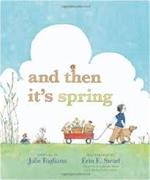 It has been an unusually difficult winter in New England this year, with several feet of snow arriving in the region. Although my Bernese Mountain Dog, Lance, has enjoyed every flake, I find myself longing for the first day of spring. That sense of joy—of the brown, dry earth coming to life—has been brilliantly captured in Julie Fogliano’s And Then It’s Spring. A perfect book to use to explain cycles of life, or the seasons, to 2- through 8-year-olds, the text begins “First you have brown, all around you have brown.” Then a young boy plants seeds and wishes for rain, until the color becomes “a hopeful, very possible sort of brown.” As the boy places more seeds in the earth, he worries about them, fearing that birds and bears might have taken them away. But, at the end of the story, just as the boy hoped, the brown earth has been replaced by green.
It has been an unusually difficult winter in New England this year, with several feet of snow arriving in the region. Although my Bernese Mountain Dog, Lance, has enjoyed every flake, I find myself longing for the first day of spring. That sense of joy—of the brown, dry earth coming to life—has been brilliantly captured in Julie Fogliano’s And Then It’s Spring. A perfect book to use to explain cycles of life, or the seasons, to 2- through 8-year-olds, the text begins “First you have brown, all around you have brown.” Then a young boy plants seeds and wishes for rain, until the color becomes “a hopeful, very possible sort of brown.” As the boy places more seeds in the earth, he worries about them, fearing that birds and bears might have taken them away. But, at the end of the story, just as the boy hoped, the brown earth has been replaced by green.
Brave Girl: Clara and the Shirtwaist Makers’ Strike of 1909 by Michelle Markel
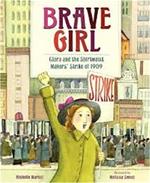 Clara Lemlich was born March 28, 1886, in the Ukraine to a Jewish family. Following a pogrom in 1903, Clara and her family immigrated to the United States. She stood a mere 5 feet tall, but as Brave Girl tells us, she had grit and was going to prove it. No one will hire Clara’s father; so to support her family, this intrepid teenager goes to work in the garment industry, carrying her own sewing machine each day. That industry has set up harsh rules for workers—a few minutes late means losing a half-day’s pay, and a girl can be fired for pricking a finger and bleeding on the cloth. Working by day and going to school at night so she could learn English, Clara tries to make her way in the world. But as she begins to understand what is happening in the workplace, Clara finds herself smoldering with anger over the treatment of the women. She becomes an organizer of pickets and strikes; she’s arrested 17 times and has six broken ribs to prove it. Then in 1909, Clara helps women organize the largest walkout of women workers in the history of the United States.
Clara Lemlich was born March 28, 1886, in the Ukraine to a Jewish family. Following a pogrom in 1903, Clara and her family immigrated to the United States. She stood a mere 5 feet tall, but as Brave Girl tells us, she had grit and was going to prove it. No one will hire Clara’s father; so to support her family, this intrepid teenager goes to work in the garment industry, carrying her own sewing machine each day. That industry has set up harsh rules for workers—a few minutes late means losing a half-day’s pay, and a girl can be fired for pricking a finger and bleeding on the cloth. Working by day and going to school at night so she could learn English, Clara tries to make her way in the world. But as she begins to understand what is happening in the workplace, Clara finds herself smoldering with anger over the treatment of the women. She becomes an organizer of pickets and strikes; she’s arrested 17 times and has six broken ribs to prove it. Then in 1909, Clara helps women organize the largest walkout of women workers in the history of the United States.
Marching for Freedom by Elizabeth Partridge
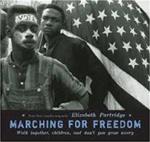 On March 21, 1965, Dr. Martin Luther King Jr. began the 5-day protest march from Selma to Montgomery, Alabama—a triumphant event in the Civil Rights movement. A few months later, the Voting Rights Act was signed into law, outlawing literacy tests and other measures used to keep African Americans from registering to vote. A remarkable book came out in 2009, Marching for Freedom: Walk Together, Children, and Don’t You Grow Weary by Elizabeth Partridge, which explores in vivid detail the eight tumultuous months in 1965 that ended with the Voting Rights Act. On January 2, Dr. Martin Luther King Jr. spoke at the Brown Chapel African Methodist Episcopal Church in Selma: “We’re not on our knees begging for the ballot. We are demanding the ballot.” On March 7, Bloody Sunday, troopers turned tear gas and billy clubs on peaceful marchers. By the time readers come to the events of March 21, they completely understand what is at stake—and just how brutal the fight for voting rights was.
On March 21, 1965, Dr. Martin Luther King Jr. began the 5-day protest march from Selma to Montgomery, Alabama—a triumphant event in the Civil Rights movement. A few months later, the Voting Rights Act was signed into law, outlawing literacy tests and other measures used to keep African Americans from registering to vote. A remarkable book came out in 2009, Marching for Freedom: Walk Together, Children, and Don’t You Grow Weary by Elizabeth Partridge, which explores in vivid detail the eight tumultuous months in 1965 that ended with the Voting Rights Act. On January 2, Dr. Martin Luther King Jr. spoke at the Brown Chapel African Methodist Episcopal Church in Selma: “We’re not on our knees begging for the ballot. We are demanding the ballot.” On March 7, Bloody Sunday, troopers turned tear gas and billy clubs on peaceful marchers. By the time readers come to the events of March 21, they completely understand what is at stake—and just how brutal the fight for voting rights was.
Novels
Calvin Coconut #9: Extra Famous by Graham Salisbury
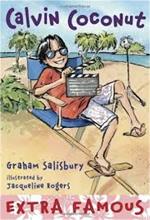 March is Humorists Are Artists Month. I totally agree with this sentiment. So often, when children are asked what kind of book they want to read, they respond, “a funny book.” And yet the craft of making this type of book often gets overlooked and is rarely awarded. So I’d like to acknowledge the comic genius of Graham Salisbury in Calvin Coconut #9: Extra Famous. As a writer, Graham demonstrated his ability to craft fascinating and serious historical fiction for older readers, in books such as Under the Blood-Red Sun. But several years ago when he began to write for children ages 7–10, Salisbury used Hawaii—the state where he grew up—for the setting and employed a much lighter touch with the content.
March is Humorists Are Artists Month. I totally agree with this sentiment. So often, when children are asked what kind of book they want to read, they respond, “a funny book.” And yet the craft of making this type of book often gets overlooked and is rarely awarded. So I’d like to acknowledge the comic genius of Graham Salisbury in Calvin Coconut #9: Extra Famous. As a writer, Graham demonstrated his ability to craft fascinating and serious historical fiction for older readers, in books such as Under the Blood-Red Sun. But several years ago when he began to write for children ages 7–10, Salisbury used Hawaii—the state where he grew up—for the setting and employed a much lighter touch with the content.
Ella Enchanted by Gail Carson Levine
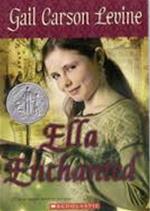 Gail Carson Levine’s Ella Enchanted relies on the content and structure of “Cinderella.” Although this fairy tale can be traced back to the first century BC, the best-known version in the west was created by French writer Charles Perrault in 1697. For anyone hunting for a folk tale to show children how the same story is told in different cultures, Cinderella remains one of the best—with great cultural adaptations such as John Steptoe’s Mufaro’s Beautiful Daughters, Rafe Martin’s The Rough-Face Girl, and Ai-Ling Louie’s Yeh-Shen. For Ella Enchanted, however, Gail Carson Levine took the story and expanded and changed it, making it into something completely new. As a baby, Ella, daughter of a wealthy merchant father and fairy mother, receives a gift from the fairy, Lucinda. She is given obedience—something that proves to be a curse. If someone commands Ella to do something, she cannot refuse, even if it would be in her best interest to do so. While her mother lives, Ella can be protected from the worst problems this gift causes. But after her mother’s death, she suddenly finds herself in finishing school and at the mercy of an odious student who has discovered her secret. In this vaguely medieval land of giants, elves, and ogres (languages that Ella can speak), Ella runs away, searching for Lucinda to get her curse removed.
Gail Carson Levine’s Ella Enchanted relies on the content and structure of “Cinderella.” Although this fairy tale can be traced back to the first century BC, the best-known version in the west was created by French writer Charles Perrault in 1697. For anyone hunting for a folk tale to show children how the same story is told in different cultures, Cinderella remains one of the best—with great cultural adaptations such as John Steptoe’s Mufaro’s Beautiful Daughters, Rafe Martin’s The Rough-Face Girl, and Ai-Ling Louie’s Yeh-Shen. For Ella Enchanted, however, Gail Carson Levine took the story and expanded and changed it, making it into something completely new. As a baby, Ella, daughter of a wealthy merchant father and fairy mother, receives a gift from the fairy, Lucinda. She is given obedience—something that proves to be a curse. If someone commands Ella to do something, she cannot refuse, even if it would be in her best interest to do so. While her mother lives, Ella can be protected from the worst problems this gift causes. But after her mother’s death, she suddenly finds herself in finishing school and at the mercy of an odious student who has discovered her secret. In this vaguely medieval land of giants, elves, and ogres (languages that Ella can speak), Ella runs away, searching for Lucinda to get her curse removed.
Everything on a Waffle by Polly Horvath
Waffles have a long, glorious history. In Colonial times, President Thomas Jefferson brought a long-handled waffle iron from France to the United States. In 1869, Cornelius Swarthout, a man with a great Dutch name, patented the first U.S. waffle iron. Polly Horvath’s quirky and funny Everything on a Waffle, is a Newbery Honor Book. Living in Coal Harbour, British Columbia, Primrose Squarp, an 11-year-old with hair the color of “carrots in an apricot glaze,” loses both parents when a typhoon blows them out to sea. She always believes them to be simply lost; her neighbors and those at school insist they must be dead and that Primrose must live in reality. But reality is not Primrose’s strong suit—she excels in imagination and whimsy. Eventually, her bachelor uncle Jack moves to Coal Harbour to care for her. He also seems attracted to the possible real estate development of this now-sleepy little spot. Even under his care Primrose manages to get into a lot of scrapes in chapters entitled “I Lose a Toe” and “I Lose Another Digit.” For a short time, she gets placed with a foster family, but she continues to believe in a happy ending to her plight—when her parents return.
How to Steal a Dog by Barbara O’Connor
 When I thought about a funny, engaging character who faces an ethical dilemma, Georgina Hayes of Barbara O’Connor’s How to Steal a Dog came instantly to mind. O’Connor moves with grace through this story of a young girl, abandoned by her father and now facing hard times. Her opening line grabs readers’ attention immediately: “The day I decided to steal a dog was the same day my best friend, Luanne Godfrey, found out I lived in a car.” Thrown out of their apartment because they cannot pay rent, Georgina, her mother, and her younger brother, Toby, all work desperately to keep their lives as normal as possible. Georgina becomes more and more unkempt, begins to fail at school, and loses her friends. But she is a girl with a plan—she wants to help her mother get enough money for a deposit on a place to live. When she sees a sign that offers a $500 reward for finding a dog, Georgina’s mind begins working overtime. If she can’t find this dog, why not steal another one and then claim the money?
When I thought about a funny, engaging character who faces an ethical dilemma, Georgina Hayes of Barbara O’Connor’s How to Steal a Dog came instantly to mind. O’Connor moves with grace through this story of a young girl, abandoned by her father and now facing hard times. Her opening line grabs readers’ attention immediately: “The day I decided to steal a dog was the same day my best friend, Luanne Godfrey, found out I lived in a car.” Thrown out of their apartment because they cannot pay rent, Georgina, her mother, and her younger brother, Toby, all work desperately to keep their lives as normal as possible. Georgina becomes more and more unkempt, begins to fail at school, and loses her friends. But she is a girl with a plan—she wants to help her mother get enough money for a deposit on a place to live. When she sees a sign that offers a $500 reward for finding a dog, Georgina’s mind begins working overtime. If she can’t find this dog, why not steal another one and then claim the money?
Mrs. Piggle-Wiggle by Betty MacDonald
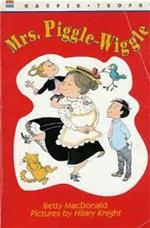 Because her father worked as a mining engineer, Betty MacDonald spent many years of her childhood traveling around the West. Eventually settling in Seattle, MacDonald attended the University of Washington and wrote The Egg and I, a funny account of her married life on a chicken farm. As accomplished as her adult books were, MacDonald is remembered and celebrated for her series of books for children ages 6–10 about a charming, but no-nonsense widow who lives in a small town named Mrs. Piggle-Wiggle. Although experts like to say that children want to read books only about other children and are not interested in adults, Mrs. Piggle-Wiggle is an exception to that rule. She loves children and entertains them in a house she has turned upside down. To these young people she gives sound advice about living with and understanding parents.
Because her father worked as a mining engineer, Betty MacDonald spent many years of her childhood traveling around the West. Eventually settling in Seattle, MacDonald attended the University of Washington and wrote The Egg and I, a funny account of her married life on a chicken farm. As accomplished as her adult books were, MacDonald is remembered and celebrated for her series of books for children ages 6–10 about a charming, but no-nonsense widow who lives in a small town named Mrs. Piggle-Wiggle. Although experts like to say that children want to read books only about other children and are not interested in adults, Mrs. Piggle-Wiggle is an exception to that rule. She loves children and entertains them in a house she has turned upside down. To these young people she gives sound advice about living with and understanding parents.
Rules by Cynthia Lord
 In the past few years, several notable children’s books have included a child with autism or a focus on autism. My favorite book on the topic remains Cynthia Lord’s Rules. Not only does she deal with how autism affects a family but she also writes a compelling story with a believable and totally lovable protagonist. All 12-year-old Catherine longs for is a normal life and a chance to have a reasonable conversation with her young brother David. But he suffers from autism, and the family, slowly and inextricably, begins to revolve around his disability and his needs—rather than Catherine’s. In order to make their life more normal, Catherine tries to help David grow and mature. David’s autism makes him a stickler for rules, so she makes a list of rules for him that include imperatives like: “Don’t stand in front of the TV when other people are watching it.” Or “No toys in the fish tank.” However, no matter how many rules Catherine can think of, David always manages to careen out of control.
In the past few years, several notable children’s books have included a child with autism or a focus on autism. My favorite book on the topic remains Cynthia Lord’s Rules. Not only does she deal with how autism affects a family but she also writes a compelling story with a believable and totally lovable protagonist. All 12-year-old Catherine longs for is a normal life and a chance to have a reasonable conversation with her young brother David. But he suffers from autism, and the family, slowly and inextricably, begins to revolve around his disability and his needs—rather than Catherine’s. In order to make their life more normal, Catherine tries to help David grow and mature. David’s autism makes him a stickler for rules, so she makes a list of rules for him that include imperatives like: “Don’t stand in front of the TV when other people are watching it.” Or “No toys in the fish tank.” However, no matter how many rules Catherine can think of, David always manages to careen out of control.
Poetry
Dark Emperor & Other Poems of the Night by Joyce Sidman
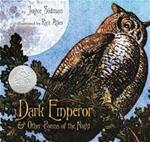 As publisher at Houghton Mifflin, I saw the manuscript for Joyce Sidman’s first book of poems, The World According to Dog, which was sent to me by her editor Ann Rider. I loved Joyce’s voice and her ability to capture the essence of an animal in a few well-chosen words. Also, I was a natural enthusiast for a book of well-written dog poems. Since that time, Joyce’s books have won more major awards than most poets for children ever see, including a Caldecott Honor and a Newbery Honor this year for Dark Emperor & Other Poems of the Night. When I read this book, and her other title published in 2010, Ubiquitous: Celebrating Nature’s Survivors, I realized I still loved her voice. In these 10 years, Joyce has moved from a poet of promise to a seasoned, intelligent craftsperson who selects ambitious subjects for books.
As publisher at Houghton Mifflin, I saw the manuscript for Joyce Sidman’s first book of poems, The World According to Dog, which was sent to me by her editor Ann Rider. I loved Joyce’s voice and her ability to capture the essence of an animal in a few well-chosen words. Also, I was a natural enthusiast for a book of well-written dog poems. Since that time, Joyce’s books have won more major awards than most poets for children ever see, including a Caldecott Honor and a Newbery Honor this year for Dark Emperor & Other Poems of the Night. When I read this book, and her other title published in 2010, Ubiquitous: Celebrating Nature’s Survivors, I realized I still loved her voice. In these 10 years, Joyce has moved from a poet of promise to a seasoned, intelligent craftsperson who selects ambitious subjects for books.
Love That Dog by Sharon Creech
 If I could make any single volume the book of the month, I would choose Sharon Creech’s Love That Dog, published by the Newbery Medal winner author in 2001. In a small volume of 100 pages, Sharon uses free verse to celebrate poetry and the writing of poetry. Love That Dog also provides a lesson in modern poetic forms. And it shows, in a believable way, a young reader who becomes an advocate of poetry — a form he once hated. On the first page we meet Jack, a student of Miss Stretchberry’s. He tells us simply “I don’t want to/because boys/don’t write poetry./Girls do.” But then readers watch Jack make some small attempts and respond to poems being read. (Many of these have been included in the book.) As the school year progresses from September through June, Jack develops as a writer—responding in more sophisticated ways to what has been presented to him. Over time, his own poetry grows in complexity and skill.
If I could make any single volume the book of the month, I would choose Sharon Creech’s Love That Dog, published by the Newbery Medal winner author in 2001. In a small volume of 100 pages, Sharon uses free verse to celebrate poetry and the writing of poetry. Love That Dog also provides a lesson in modern poetic forms. And it shows, in a believable way, a young reader who becomes an advocate of poetry — a form he once hated. On the first page we meet Jack, a student of Miss Stretchberry’s. He tells us simply “I don’t want to/because boys/don’t write poetry./Girls do.” But then readers watch Jack make some small attempts and respond to poems being read. (Many of these have been included in the book.) As the school year progresses from September through June, Jack develops as a writer—responding in more sophisticated ways to what has been presented to him. Over time, his own poetry grows in complexity and skill.
Stardines Swim High Across the Sky and Other Poems by Jack Prelutsky
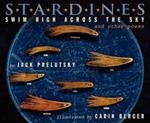 In Stardines Swim High Across the Sky and Other Poems, Jack Prelutsky, America’s first Children’s Book Laureate, has created 16 poems that combine the animate and inanimate world. “Stardines swim high across the sky,/And brightly shine as they glide by./In giant schools, their brilliant lights/Illuminate the darkest nights.” With her signature collage artwork, Berger places the “stardines” at appropriate spots in the night sky. Then the readers meet a whole group of creatures: bluffaloes who combine attitude and bulk, fountain lions who run water day and night, messy slobsters, noisy magpipes, and happy jollyfish. Each imaginary creature has been given a short but snappy poem to describe its qualities. Prelutsky’s poetry is always fun to read aloud. But this volume is particularly spectacular in its artistic treatment. The entire book has been set up as a scientist’s specimen book or box, and many of the pages are lined as if placed on tablet paper.
In Stardines Swim High Across the Sky and Other Poems, Jack Prelutsky, America’s first Children’s Book Laureate, has created 16 poems that combine the animate and inanimate world. “Stardines swim high across the sky,/And brightly shine as they glide by./In giant schools, their brilliant lights/Illuminate the darkest nights.” With her signature collage artwork, Berger places the “stardines” at appropriate spots in the night sky. Then the readers meet a whole group of creatures: bluffaloes who combine attitude and bulk, fountain lions who run water day and night, messy slobsters, noisy magpipes, and happy jollyfish. Each imaginary creature has been given a short but snappy poem to describe its qualities. Prelutsky’s poetry is always fun to read aloud. But this volume is particularly spectacular in its artistic treatment. The entire book has been set up as a scientist’s specimen book or box, and many of the pages are lined as if placed on tablet paper.
With a unique career in children's books, Anita Silvey has served both as the editor of The Horn Book Magazine and as a publisher of a major children's book imprint. She is the author of several books, including Henry Knox: Bookseller, Soldier, Patriot and I’ll Pass for Your Comrade: Women Soldiers in the Civil War. Her latest project, The Children’s Book-a-Day Almanac, is an interactive website she describes as a “daily love letter to a book or author,” with each entry offering a glimpse into the story behind the story. Her columns are culled from the reviews on her website.